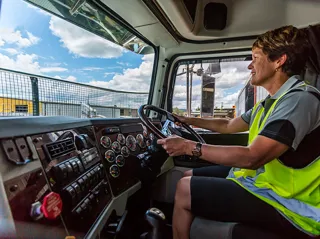There are now currently record levels of HGV driving tests being carried out, new data produced by the Department for Transport (DfT) shows.
Although it is hard to be certain the numbers are solely due to HGV bootcamps, says the Road Haulage Association (RHA), it labelled the figures “hugely positive”, and a clear sign that the sector is attracting high levels of drivers and first learners passing via the scheme.
The March figures of 10,481 tests and 6,307 passes can be compared to the pre-Covid pandemic era, where the previous record was 4,268 passes and 7,323 tests, which was recorded in March 2017.
Additionally, there has been an increase in the number of tests across a longer period too. From September 2021 to March 2022, there has also been a record number of drivers taking tests.
The RHA says that the positive media stories about the sector and promoting the role of HGV driver has played a significant role – alongside the increases in salary.
Speaking about the findings, policy lead for skills at the RHA, Sally Gilson, said: “These record results show what happens when a government prioritises and promotes a sector.
“If the numbers continue to look this good, it shows the extent to which bringing a flexible, fully-funded training programme can impact the HGV and logistics industry.”
| Year | Tests Taken | Tests Passed |
| Q1 2022 | 26,388 | 15,971 |
| Q1 2021 | 15,194 | 9,079 |
| Q1 2019 | 18,460 | 10,927 |
Transport and logistics ‘UK’s fastest growing sector’
New data from the Office for National Statistics (ONS) shows the transport and logistics sector has expanded far faster than any other industry, including retail manufacturing and construction.
More new transport and supply chain business premises have opened than for any other industry.
The number of transport and logistics premises has grown by 88% since 2011 and 21% since 2019 alone, despite Brexit and Covid woes.
ParcelHero’s head of consumer research, David Jinks, said: “The growth in new premises for postal and courier operators in particular has outstripped any other area of any industry, and even outperformed the overall logistics sector growth.
“Since 2011 the number of postal and courier depots and distribution centres (DCs) has grown by an astonishing 147%, as Covid restrictions fuelled a surge in demand for home deliveries.
“The growth in transport premises as a whole has been far larger than any other sector of British industries.
“Since 2019 construction premises have grown by just 5%, retail by 3% and manufacturing by 2%. That gives a good indication of how these sectors have all struggled with Covid and Brexit.
“In contrast postal and courier business premises have grown particularly fast. In 2011 there were 17,175 postal and courier depots and warehouses in the UK, but by 2019 this had grown to 26,100. By 2021 42,500 were in operation, with most new premises opening in the so-called ‘Golden Triangle’, an area of the West Midlands focussed around Lutterworth.”
However, Jinks added that even though transport and logistics is now the largest industry in parts of the Midlands, the East of England and Yorkshire and the Humber, at least in terms of share of business units, that growth has not been reflected in the rate of pay.
“Hourly earnings in transport and storage were below the national average in 2021 (£14.76 compared with £15.65),” he said.
“Full-time staff in the transport and storage industry, such as couriers, HGV drivers and warehouse workers, worked nearly 42 hours in a typical week. The average across all industries is nearly 39 hours.”
Transport and storage workers were also more likely than those in any other industry to do overtime (32%), with those working overtime recording nearly eight additional hours per week on average.
“One reason why the average transport and warehousing jobs’ salary hasn’t boomed in line with the growth of the sector is that less new jobs have been created than might be expected, looking at the number of new warehouses and DCs erected,” said Jinks.
“While the number of business premises has almost doubled in the last 10 years, employment in transport and storage was only 20% higher in December 2021, compared with December 2011.
“That’s because warehouses are increasingly automated and use many leading-edge technologies, such as voice picking and sophisticated warehouse management systems (WMS), to increase the speed of operations and reduce the need for manual activities.”
























Login to comment
Comments
No comments have been made yet.